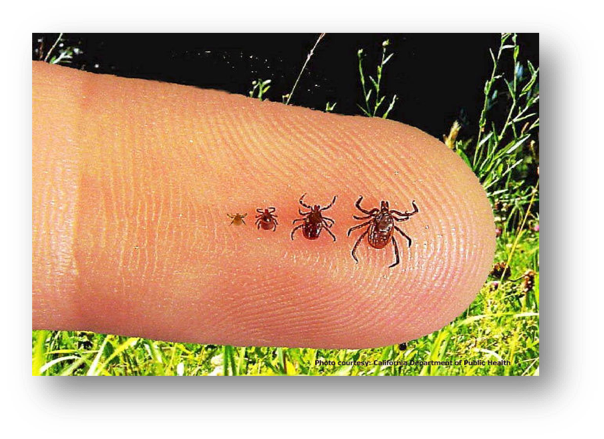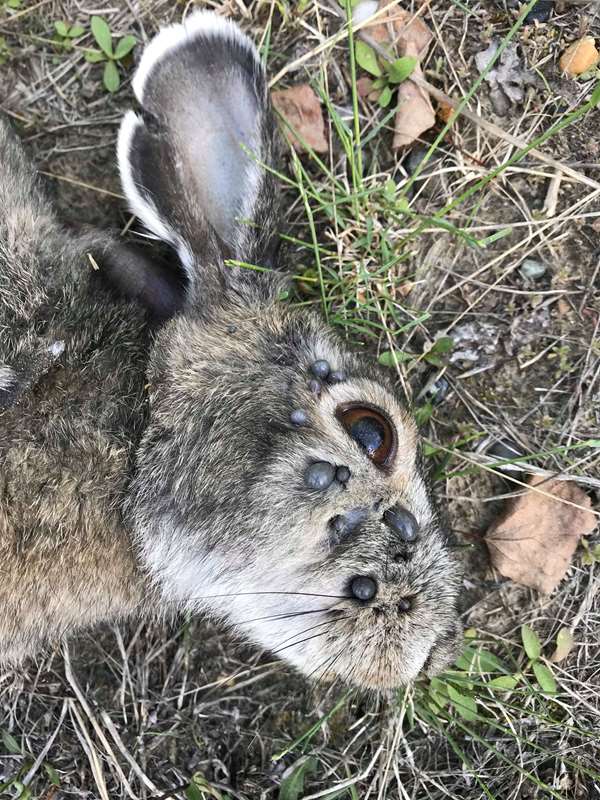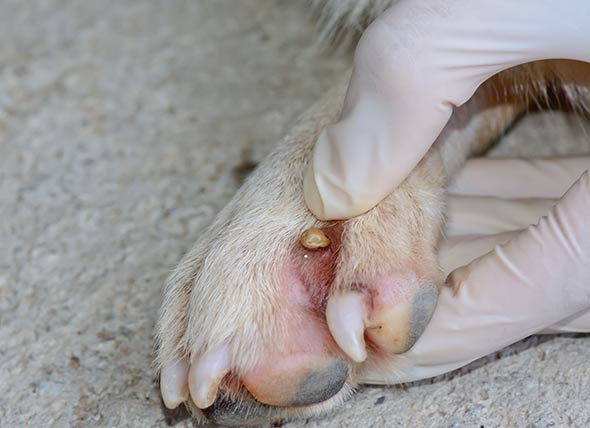By: Micah Hahn, PhD, MPH, University of Alaska Anchorage, Institute for Circumpolar Health Studies and William George, MS Candidate; University of Alaska Anchorage
The effect of global environmental change, particularly climate change, on the distribution of species across the globe has been widely assessed [1]. While many lower-latitude ecosystems are becoming too warm or too dry to support native plant and animal species, we are seeing poleward shifts in the distribution of a variety of species that impact food webs [2], intertidal ecosystems [3], and carbon sequestration [4]. In the Arctic, a tiny creature is having a big impact on human and wildlife health.
In Alaska, a new study is helping us understand if invasive ticks are being imported, and surviving, in the Last Frontier. Amid concerns about the introduction of the winter moose tick (Dermacentor albipictus), the Alaska Department of Fish and Game and the Office of the State Veterinarian began informally accepting ticks from Alaskans in 2012. Through this program, they found that several non-native ticks were coming into the state. With a new partnership with the University of Alaska Anchorage (UAA), they will now be able formally assess the risk of ticks and tick-borne pathogens.
How are ticks being imported into the state?
Once researchers discovered that non-native ticks were arriving in Alaska, they wanted to find out how they were being imported. A better understanding of these vector dynamics can help us design more effective surveillance strategies and policies to detect ticks early and prevent their establishment in new areas. There are likely three primary routes of tick importation into the state: (1) people and pets traveling to tick endemic regions, (2) migratory birds, and (3) large and small mammal movement from the Canadian border.
During the 2018 fiscal year, over 3.3 million passengers traveled by plane from Alaska [5], and an increasing number of these people travel with pets. If only 10 percent of these passengers traveled to tick endemic areas, spent time outdoors, and returned, that would mean that 330,000 passengers could accidentally bring a non-native tick back into Alaska on their laundry or attached to their skin. Most Alaskans, and likely most pet owners in regions with low tick numbers, do not use tick prevention on their animals. Some ticks can feed for multiple days at a time [6], so pets traveling to tick endemic areas also provide a direct route for non-native ticks to Alaska.
Along with people traveling outside of Alaska, migratory birds may be a mode of transport for non-native ticks into the state. Bird surveys in Canada have shown that birds are an important route of tick movement [7, 8]. Over 320 different bird species migrate to Alaska from Europe, Canada, South/Central America, and the continental U.S. for the spring/summer months (See: eBird). The UAA tick project is working with bird biologists around the state to assess the extent of tick importation on migratory birds.
Finally, large and small movement between Canada and Alaska could be a source of non-native tick importation. A collaborative study between the Arctic Refuge in Alaska and the Old Crow village in northern Canada, found that moose migrate between the two locations during the winter and summer months. Their study showed that moose moved into the Arctic Refuge each fall, and then 75% left for Old Crow village each spring and summer [9]. Recent reports of mule deer in Alaska, likely travelers from the Yukon where moose ticks are prevalent, have also raised the possibility of tick importation on this species [10].
How do we find ticks?
A key component in the first year of the new project is the development of the Alaska Submit-A-Tick Program. Through this program, individuals who find ticks on themselves, their family members, pets, or wildlife (e.g., hunted or trapped animals) can submit ticks for species identification and pathogen testing. The project team has also been developing an extensive web resource on ticks in Alaska, which will be a key reference for the public, veterinarians, health care professionals, and wildlife biologists who want to learn more about ticks in the state. This summer, the UAA team is also conducting field work to look for ticks in parks with high human, dog, and wildlife traffic.



Where else are ticks being tracked in the Arctic?
Ticks are not just being tracked in Alaska. In Norway, researchers from the Norwegian Polar Institute have been keeping an eye on ticks found on seabirds since 2013 [11]. Their study assesses how the shift in global temperatures is affecting nesting coastal seabirds that are parasitized by Ixodes uriae. In one of the bird colonies, they found that a 1C increase in winter temperatures was associated with a 5% increase in tick prevalence the following summer [11]. These results suggest that as the Arctic becomes warmer, ticks may be able to establish in areas that were previously inhospitable.
In Russia, a group of researchers tracked the movement of Ixodes persulcatus and tick-borne encephalitis (TBE) in Arkhangelsk Oblast, a north European Russian territory. They used the increase in mean annual air temperatures and mean temperatures during tick active season to determine the extent of northern expansion of I. persulcatus [12]. They found that the establishment of I. persulcatus in Arkhangelsk Oblast was related to the increase in both mean annual air temperatures and number of days with effective temperatures that exceeded 10C from 1980 to 2009 [6]. An increase in TBE cases from 162 in 1980 to 6,450 in 2009 paralleled the expansion of the tick vector.
A group of researchers in Sweden looked at the presence and expansion of Ixodes ricinus over a 30-year period between 1980 and 2009. They found that I. ricinus had expanded to many northern parts of Sweden (as far north as 66N), and the abundance of the tick had increased in the south and central parts of the country [13]. By 2009, the range of these ticks covered 26.8% of the area that was previously tick-free in Sweden, and the number of TBE and Lyme diseases in the country had increased substantially from the historical incidence [13]. The researchers concluded that a longer warm season increased the length of the reproductive period and supported proliferation of the roe deer, an important tick host.
The need for regional coordination
Invasive species do not stop at country borders. Regional coordination across the Arctic can make invasive species surveillance and management more efficient and can help build and reinforce international relationships. This could be done by creating an Arctic tick surveillance working group to share data, new methods of surveillance, and management strategies.
This Arctic tick surveillance working group could build on the Arctic Council's Arctic Invasive Alien Species (ARIAS) action plan that highlights priority actions to protect Arctic ecosystems from invasive species. The working group should extend to ecologists, public health professionals, and the medical and veterinary communities.
The working group should prioritize the development of systematic data collection and data sharing protocols. Data could include presence and abundance of tick species, sex, and lifestage, presence and abundance of mammalian hosts as well as information on host movement and range, pathogen prevalence in ticks and hosts, environmental data such as climate and vegetation, and incidence of tick-borne disease in humans and animals. As next-generation sequencing techniques for species and pathogen identification become more prevalent, these data could also include genetic information so that invasive tick species can be matched to their origin.
The working group could also develop and evaluate strategies for reducing the importation of ticks and managing the tick population once they have been detected. For example, increasing pet screenings at airports or managing the density of large and small mammal hosts at the margins of the tick range could help limit non-native tick introductions and spread to new areas.
Public outreach and education should also be a priority for the working group. Passive surveillance has been an effective and low-cost method for detecting the emergence of ticks [14–16]. In addition to casting a wide net to collect tick specimens, involving the public in surveillance programs also provides an opportunity to increase awareness about strategies for protecting against tick bites. This is particularly important in areas of tick emergence where people are not used to doing tick checks after a hike or putting their clothes in the dryer to kill ticks they may have missed. Equally important is working with medical and veterinary practitioners to improve early diagnosis of tick-borne diseases. Clinicians working in Arctic communities need to be familiar with the symptoms of tick-borne diseases, and continued surveillance can provide information on the areas where people can be exposed to ticks and tick-borne pathogens.
As the Artic environment continues to undergo rapid change, we can expect shifts in species distributions and ecosystem dynamics. Ticks and other arthropod vectors are particularly sensitive to changes in climate, and their distribution will continue to shift over the coming decades. Collaboration across Arctic nations to detect and control the movement of these species can help prevent vector-borne diseases in people and domestic and wild animals.
To learn more about the project or to order outreach materials or field kits to integrate tick checks into your wildlife research project, please contact Micah Hahn (mbhahn [at] alaska.edu), the project lead.
This project is funded by the Alaska INBRE Program (Institutional Development Award (IDeA) from the National Institute of General Medical Sciences of the National Institutes of Health under grant number P20GM103395).
For more information about ticks in Alaska, visit the State of Alaska Division of Environmental Health State Veterinarian's Information on Ticks.
For more information about ticks and tick-borne diseases visit:
The Centers for Disease Control and Prevention's page, Ticks
and the European Centre for Disease Prevention and Control's page, Tic-borne diseases.
About the Authors
 Dr. Hahn is an Assistant Professor of Environmental Health within the Institute for Circumpolar Health Studies at University of Alaska Anchorage. Her research focuses on the health impacts of climate change and climate adaptation and resilience planning in Alaska. Although she is open to projects and collaborations that broadly address environmental health topics, her priority research areas are ecological questions at the center of OneHealth, strategies to improve food security and local food production, and the health co-benefits of climate mitigation. Dr. Hahn is committed to interdisciplinarity, collaboration, and community engagement. Prior to joining UAA, she spent time at the Centers for Disease Control and Prevention developing ecological models related to West Nile virus and Lyme disease. She is currently working with the Municipality of Anchorage to develop and implement their Climate Action Plan and with communities around the state on community resilience planning in the context of environmental change. She is also leading the study to investigate the risk of ticks and tick-borne pathogens in Alaska described above.
Dr. Hahn is an Assistant Professor of Environmental Health within the Institute for Circumpolar Health Studies at University of Alaska Anchorage. Her research focuses on the health impacts of climate change and climate adaptation and resilience planning in Alaska. Although she is open to projects and collaborations that broadly address environmental health topics, her priority research areas are ecological questions at the center of OneHealth, strategies to improve food security and local food production, and the health co-benefits of climate mitigation. Dr. Hahn is committed to interdisciplinarity, collaboration, and community engagement. Prior to joining UAA, she spent time at the Centers for Disease Control and Prevention developing ecological models related to West Nile virus and Lyme disease. She is currently working with the Municipality of Anchorage to develop and implement their Climate Action Plan and with communities around the state on community resilience planning in the context of environmental change. She is also leading the study to investigate the risk of ticks and tick-borne pathogens in Alaska described above.
 William George is a graduate student in the Department of Biological Sciences at University of Alaska Anchorage. His research focuses on viral surveillance and evolution in the Alaskan bat, Myotis lucifugus. The virus that he is interested in is coronavirus, having zoonotic potential to 'jump' from one species to another through direct or indirect interaction, sometimes using intermediate hosts. With his research, not only will the virome of Alaskan bats be better understood but so too the nature of Alaskan coronaviruses and its evolution allowing the virus to remain persistent in these Arctic bats without causing harm to the host or surrounding species.
William George is a graduate student in the Department of Biological Sciences at University of Alaska Anchorage. His research focuses on viral surveillance and evolution in the Alaskan bat, Myotis lucifugus. The virus that he is interested in is coronavirus, having zoonotic potential to 'jump' from one species to another through direct or indirect interaction, sometimes using intermediate hosts. With his research, not only will the virome of Alaskan bats be better understood but so too the nature of Alaskan coronaviruses and its evolution allowing the virus to remain persistent in these Arctic bats without causing harm to the host or surrounding species.
References
- Hobbs, R.J., L.E. Valentine, et al. 2018. Movers and Stayers: Novel Assemblages in Changing Environments. Trends in Ecology & Evolution 33(2):116–128.
- Kortsch S., R. Primicerio, et al. 2015. Climate change alters the structure of arctic marine food webs due to poleward shifts of boreal generalists. Proceedings of the Royal Society B: Biological Sciences 282 (1814): 20151546.
- Jueterbock, A., I. Smolina, et al. 2016. The fate of the Arctic seaweed Fucus distichus under climate change: an ecological niche modeling approach. Ecology and Evolution 6(6): 1712–1724
- Sørensen M.V., B.J. Graae, et al. 2018. Experimental herbivore exclusion, shrub introduction, and carbon sequestration in alpine plant communities. BMC Ecology 18(1): 29.
- Statistics, Alaska International Airport System, Transportation & Public Facilities, State of Alaska.
- Richter, D., F-R. Matuschka, et al. 2013. How ticks get under your skin: insertion mechanics of the feeding apparatus of Ixodes ricinus ticks. Proceedings of the Royal Society B: Biological Sciences 280(1773).
- Morshed M.G., J.D. Scott, et al. 2005. Migratory soungbirds disperse ticks across Canada, and the first isolation of the Lyme disease spirochete, Borrelia burgdorferi, from the avian tick, Ixodes auritulus. Journal of Parasitology 91(4).
- Ogden N.H., L.R. Lindsay, et al. 2008. Role of migratory birds in introduction and range expansion of Ixodes scapularis ticks and of Borrelia burgdorferi and Anaplasma phagocytophilum in Canada. Applied and Environmental Microbiology 74(6).
- Where do the moose go? Solving a Moose Migration Mystery - Arctic - U.S. Fish and Wildlife Service. 2014.
- Ellis, T. 2017. State asks for mule deer sightings due to concern about spread of moose winter tick. Alaska Public Media.
- Descamps, S. 2013. Winter temperature affects the prevalence of ticks in an Arctic seabird. PLOS ONE 8(6).
- Tokarevich, N.K., A.A. Tronin, et al. 2011. The impact of climate change on the expansion of Ixodes persulcatus habitat and the incidence of tick-borne encephalitis in the north of European Russia. Global Health Action, 4.
- Jaenson, T.G., D.G. Jaenson, et al. 2012. Changes in the geographical distribution and abundance of the tick Ixodes ricinus during the past 30 years in Sweden. Parasites & Vectors 5: 8.
- Koffi, J.K., P.A. Leighton, et al. 2012. Passive surveillance for I. scapularis ticks: enhanced analysis for early detection of emerging Lyme disease risk. Journal of Medical Entomology 49(2), 400–409.
- Ogden, N.H., L. Trudel, et al. 2006. Ixodes scapularis ticks collected by passive surveillance in Canada: analysis of geographic distribution and infection with Lyme borreliosis agent Borrelia burgdorferi. Journal of Medical Entomology 43(3), 600–609.
- Rand, P.W., E.H. Lacombe, et al. 2007. Passive surveillance in Maine, an area emergent for tick-borne diseases. Journal of Medical Entomology 44(6), 1118–1129.
